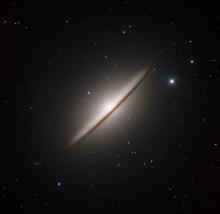Listen to today's episode of StarDate on the web the same day it airs in high-quality streaming audio without any extra ads or announcements. Choose a $8 one-month pass, or listen every day for a year for just $30.
You are here
BL Lacertae
A galaxy a billion light-years away is firing a beam of energy in our direction. Fortunately, it’s not an intergalactic weapon. Instead, it’s a “jet” that’s powered by a supermassive black hole.
BL Lacertae is in the faint constellation Lacerta, the lizard, which is high in the northeast at nightfall.
When it was discovered, in 1929, astronomers thought it was a faint star inside the Milky Way Galaxy. Decades later, though, they were able to measure its distance. At a billion light-years, the object must be extremely powerful. It’s also compact, because its light can vary over a period of hours or even minutes — something that can’t happen for large objects.
It turns out that BL Lacertae is powered by a black hole at the heart of a galaxy. The black hole is hundreds of millions of times the mass of the Sun. Gas and dust form a wide, flat disk around the black hole. Material in the disk spirals inward.
Not all of it enters the black hole, though. Radiation and powerful magnetic fields funnel some of the material into narrow jets. They shoot into space from above the poles of the black hole at almost the speed of light. We happen to align with one of the jets, so BL Lacertae shines brightly.
Astronomers have discovered hundreds of similar objects. Since BL Lacertae was the first, it’s the prototype for the entire class — giant black holes that are shooting beams of energy far into space.
Tomorrow: Stringing the universe along.
Script by Damond Benningfield






